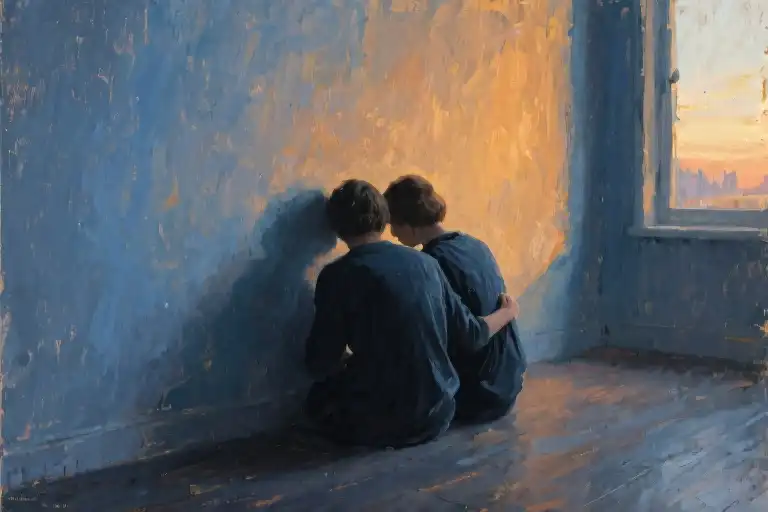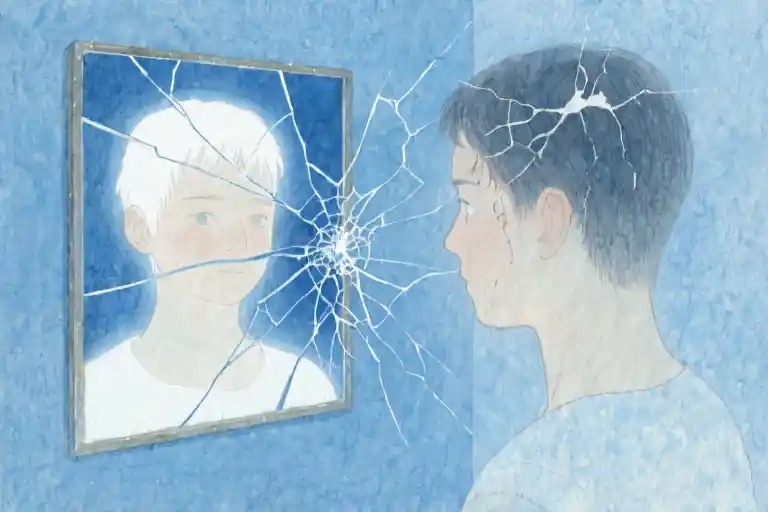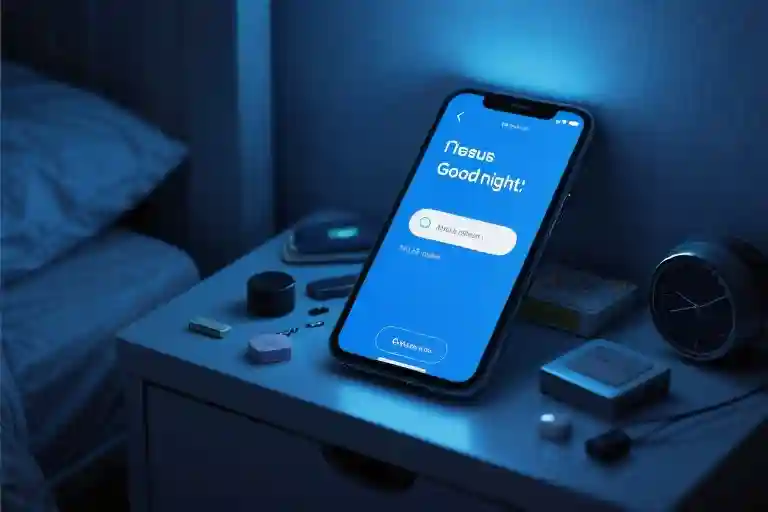The blue glow of 3:17 AM casts geometric shadows across the ceiling. In that liquid hour between night and morning, a familiar scent molecule completes its journey through your sinuses – bergamot and something indefinable, the exact chemical signature of their neck after evening showers. You don’t own that cologne anymore, haven’t smelled it in actual years, yet your olfactory memory keeps it cataloged with museum-grade precision.
They moved out of your life with forwarding addresses unknown, yet somehow took up permanent residence in your hippocampus. Neuroscientists call this pattern completion, when fragments trigger full memory retrieval. You call it involuntary time travel. The bed feels strangely configured tonight, your body still remembering the exact negative space their limbs used to occupy.
This is the paradox of emotional ghosts – they vacate your present yet keep renewing the lease on your neural real estate. That song they hated plays in a cafe and your teeth clench automatically. Your thumb hovers over the 7 key when the microwave timer beeps because that was their digit in your speed dial sequence. These phantom limbs of lost connections twitch at random stimuli, proving some bonds dissolve but never fully detach.
What makes these mental souvenirs more haunting than physical mementos is their unpredictability. You could box up photographs or donate their sweater, but there’s no attic to clean for memories that ambush you when December air hits your face a certain way, or when you catch that specific shade of golden hour light through diner windows. The past colonizes present moments with guerilla tactics, bypassing all your conscious defenses.
Yet perhaps these involuntary memories aren’t intruders but archivists. The way your hands still remember the weight of their head during feverish nights suggests some experiences are too formative to fully discard. Like childhood home blueprints etched in motor memory, certain relationships become part of your emotional architecture – their absence doesn’t negate their role in shaping the structure of who you are now.
The perfume molecule dissipates. The digital clock flips to 3:18. You turn toward the wall where their breathing should be syncing with yours, finding only cool sheets and this peculiar peace: being alone yet never quite singular, carrying conversations that ended years ago but still echo in your private cathedral of memory.
Ghost Settlements: Involuntary Colonies of Memory
The human body becomes unwilling real estate for departed relationships. Certain memories refuse eviction notices, squatting in anatomical corners we rarely think to check. These aren’t the curated recollections we willingly revisit, but rogue fragments that ambush us with the precision of a well-trained mercenary.
The Thoracic Archive operates on its own circadian rhythm. Scientists might call it cardiac coherence, but you know it as that inexplicable tightness when a particular song plays—one your ribs seem to remember better than your brain. The cadence of old conversations gets woven into your heartbeat’s pattern, surfacing when your pulse slows past a certain threshold. No amount of box breathing can evict these acoustic ghosts.
Supermarkets become minefields of retinal projection errors. That split-second when a stranger’s shoulder slope or hair flip triggers your visual cortex to scream a familiar name. The synaptic misfire lasts barely three seconds—just long enough for your hand to twitch toward a non-existent phone in your pocket. These false positives expose the shoddy programming of human memory, where the brain would rather embarrass you with mistaken identity than risk missing someone important.
Then there’s the rebellion of muscle memory insurgents. Your thumbs develop their own nostalgia, autonomously navigating to deleted contacts when tired. The keyboard app becomes a ouija board, your fingertips channeling movements they have no business remembering. You stare at the illuminated screen as if witnessing possessed hands, wondering when typing became an archaeological dig through abandoned relationships.
What makes these involuntary settlements so unsettling isn’t their persistence, but their selective precision. They don’t haunt you with major anniversaries or dramatic moments. The memories colonizing your nervous system specialize in mundane details—the exact pressure of a hand on your lower back when passing through doorways, or how someone’s laugh used to sync with the microwave’s beep. These trivialities become the shrapnel that never gets fully removed.
The body’s memorial sites operate on different rules than conscious remembrance. While we deliberately recall the highlights and low points, the autonomic nervous system archives the interstitial moments—the yawns between words, the rustle of sheets during simultaneous insomnia, the shared silence of parallel scrolling. These unremarkable instants become the most stubborn squatters, precisely because we never thought to protect against their invasion.
Perhaps this explains why time doesn’t dilute these physical memories like it does our intentional recollections. The scent receptors in your nose still recognize that discontinued cologne years later, your pupils still dilate at a particular shade of blue sweater in a crowd, your skin still anticipates a touch that stopped existing seasons ago. The body’s archives maintain their holdings with the tenacity of a librarian who refuses to retire.
These physiological memorials serve no apparent evolutionary purpose. They don’t protect us from danger or help propagate our genes. If anything, they waste precious bandwidth better spent on survival tasks. Yet they persist, these unnecessary but undeniable etchings on our cellular walls, proving that some relationships never fully leave—they just relocate to more discreet accommodations within us.
The Time-Tinted Viewfinder: How Memory Edits Our Past
The human brain operates the most sophisticated editing suite we’ll ever know. In the dim projection room of our hippocampus, an invisible editor works overtime – cutting arguments to fragments, enhancing golden-hour glow on familiar hairlines, muting harsh words while amplifying whispered confessions. This selective development process leaves us with curated memories that often bear little resemblance to their original negatives.
Neuroscience reveals our recollections aren’t archival footage but living documentaries, reshaped with each viewing. The scent of a $3 shampoo from 2012 can trigger more vivid recall than last week’s business meeting, transporting us to dorm rooms where that floral-citrus blend once lingered on shared towels. These olfactory time machines bypass rational filters, delivering uncensored emotional payloads straight to the present moment.
What’s most fascinating isn’t what memory preserves, but what it manufactures. In the parallel universe of ‘what if,’ unspoken words develop their own ecosystems. That apology you swallowed, the confession you diluted, the comeback you conceived hours too late – they’ve been breeding alternative timelines in your neural pathways. Sometimes at 3am, these ghost sentences materialize with startling clarity, their emotional weight undiminished by years of silence.
The editing bias follows predictable patterns. Conflict gets reduced to montage snippets while mundane moments achieve cinematic grandeur – the way morning light caught their eyelashes during a rushed breakfast gains higher resolution than the slammed door that followed. This isn’t accidental. Our survival wiring prioritizes memories that comfort over those that caution, creating a nostalgic filter more potent than any Instagram preset.
This explains why we can simultaneously miss someone terribly yet have zero desire to recreate the relationship. The person we long for exists primarily in our personal director’s cut – a character development far removed from the original script. When we whisper to their memory in quiet moments, we’re conversing with our own best edits, not the messy raw footage of reality.
That’s the bittersweet magic of human recall. The same mental process that helps us survive past pain also prevents us from fully letting go. Our memories become palimpsests – layered documents where each revisitation leaves fresh traces over fading originals. What remains isn’t truth, but something more valuable: the emotional essence we’ve distilled from experience, ready to be mixed into the cocktail of who we’re becoming.
The Anatomy of Contradictory Longing
There’s a particular ache that comes with missing someone you don’t actually want back. It lives in that narrow space between memory and desire, where the heart hasn’t quite updated its operating system to match the mind’s clear-eyed assessment. This isn’t about unfinished business or unresolved feelings – it’s about how certain people become emotional ruins we occasionally visit, not to rebuild but to remember what once stood there.
Attachment theory traditionally describes our need for secure bases – those steady presences we return to for comfort and reassurance. But what happens when those bases crumble? Adults develop a strange capacity to make homes out of rubble, finding something resembling comfort in the very instability that should unsettle. The person you haven’t spoken to in years becomes one such ruin, their absence paradoxically providing its own kind of grounding. You know exactly how this absence feels, its contours more familiar than most present relationships.
Cultural approaches to this phenomenon diverge sharply. Western psychology pushes for ‘closure’ – that mythical state of emotional finality where all loose ends are neatly tied. Meanwhile, the Japanese concept of ‘mono no aware’ finds beauty in the impermanence itself, in the wistful appreciation of cherry blossoms precisely because they fade. Neither approach fully captures the modern experience of longing that isn’t about either solving or savoring, but simply coexisting with echoes.
Neuroscience offers clues about why we can simultaneously miss someone yet not miss ‘us.’ The brain stores positive memories and negative associations in different neural pathways. A smell might trigger the warm recollection of a shared laugh while completely bypassing the memory of subsequent betrayal. This explains how we can genuinely cherish fragments without wanting to reconstruct the whole. Dopamine still flows when recalling certain moments, even as our prefrontal cortex firmly vetoes any return to that relationship.
What emerges isn’t contradiction but layering – like archaeological strata where different eras coexist in the same patch of ground. The deepest layer might hold genuine affection, above it rests disappointment, then resignation, and finally this peculiar peaceful acceptance that lets the missing happen without urgency to act on it. These layers don’t cancel each other out; they just take turns surfacing.
Most surprisingly, these emotional ruins serve a purpose. They become touchstones for measuring growth – not through comparison with the past, but through noticing how differently we now relate to that past. Where once these memories triggered desperate reaching, now they prompt quiet recognition: ‘Ah yes, that was real, and now this is too.’ The ruins remain, but the way we walk through them changes everything.
The Gilded Craft of Pain
The Japanese art of kintsugi doesn’t disguise broken pottery with flawless repairs. Instead, it highlights the fractures with gold lacquer, treating each crack as part of the object’s evolving history rather than evidence of damage. This philosophy mirrors what neuroscientists call traumatic growth—the paradoxical strengthening that occurs when neural pathways reorganize after emotional injury.
The Alchemy of Neural Scars
MRI scans reveal something extraordinary: the brain regions activated during grief overlap significantly with those governing physical pain perception. Yet longitudinal studies show these same areas later develop heightened sensitivity to joy. Like trees growing around barbed wire, our neural networks gradually incorporate emotional wounds into their architecture. The synaptic pathways that once carried anguish begin transmitting unexpected signals—a sunset suddenly registers as more vivid, a child’s laughter resonates deeper.
This explains why certain memories resurface with such visceral clarity years later. The amygdala tags emotionally charged moments with biochemical markers, preserving them in high-definition while mundane memories blur. What we often mistake for unfinished business is actually the brain’s gold-leaf repair work—fusing painful fragments into our identity’s foundation.
Curating Your Mental Museum
Consider the difference between a storage unit and a museum: one hoards indiscriminately, the other displays with intention. Applying this distinction to memory transforms how we process longing:
- The Wing of Transformed Artifacts
That concert ticket stub no longer represents a failed relationship, but proof you once courageously loved something enough to risk pain. - The Hall of Fragile Displays
Some memories require special handling—the sweater that still smells like them belongs in a climate-controlled case, visited only during prepared moments. - The Interactive Exhibit
Create space for reinterpretation: write letters you’ll never send, then burn them during a full moon ritual. The ashes become part of the exhibit.
The ache persists not because you’re broken, but because you’re conducting an ongoing restoration. Like kintsugi masters understanding that the gold-filled cracks increase an object’s value, your neural pathways are learning to treat emotional residue not as debris, but as raw material for gilded reconstruction.
The steam from the teapot at 6am makes the window glass weep. Across the table, ripples form and fade in the untouched teacup without any visible disturbance—the kind of quiet conversation that needs no participants.
Some dialogues were never meant to be had with people. They belong to the hour when night softens into dawn, when the boundaries between memory and reality grow porous. The cup cools as sunlight filters through the condensation, drawing liquid trails down the glass like the paths old thoughts take through your mind.
This is where certain relationships ultimately reside—not in reconciliation or resolution, but in the silent understanding that some connections exist most authentically as absences. The empty chair isn’t a void; it’s a preservation of space where a presence once altered the air. You don’t reach for your phone anymore when a particular song plays, but your fingers still remember the weight of that impulse.
Neuroscience explains this as emotional residue—the way neural pathways, once forged by significant bonds, remain like faint trails in a forest long after the frequent footsteps have ceased. Cultural traditions offer their own metaphors: the Japanese art of kintsugi, where broken pottery is repaired with gold lacquer, or the Western concept of ‘ghost limbs’ where amputees still feel phantom sensations.
What we rarely acknowledge is how these lingering impressions become part of our emotional architecture. They aren’t failures to move on, but evidence of our capacity to carry what matters. The steam dissipates, the cup empties, and the morning solidifies into day. Some goodbyes were never about leaving, but about learning how to coexist with the echoes.





